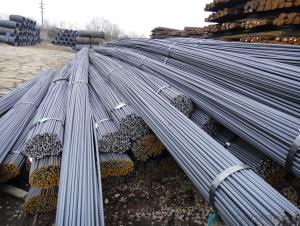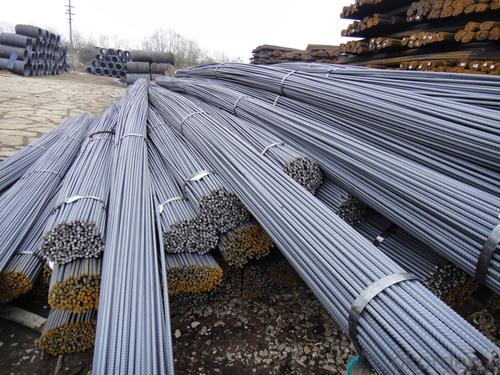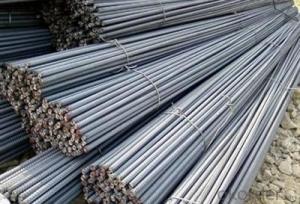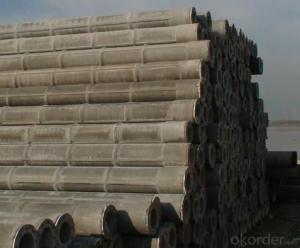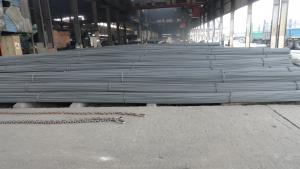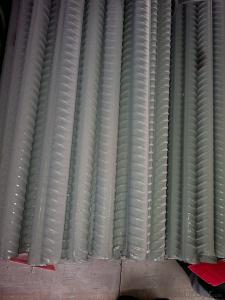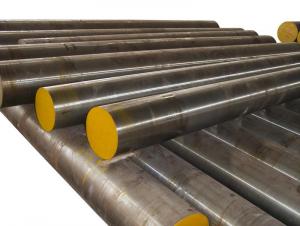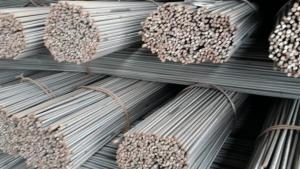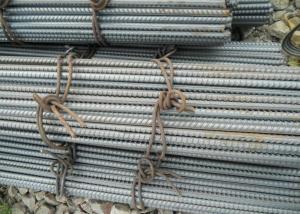Steel Ribbed Bar For Construction Hot Rolled
- Loading Port:
- China main port
- Payment Terms:
- TT OR LC
- Min Order Qty:
- 25 m.t.
- Supply Capability:
- 10000 m.t./month
OKorder Service Pledge
OKorder Financial Service
You Might Also Like
Specifications
Standard | GB | HRB400 | |
Diameter | 6mm,8mm,10mm,12mm,14mm,16mm,18mm,20mm, 22mm,25mm,28mm,32mm,36mm,40mm,50mm | ||
Length | 6M, 9M,12M or as required | ||
Place of origin | Hebei, China mainland | ||
Advantages | exact size, regular package, chemical and mechanical properties are stable. | ||
Type | Hot rolled deformed steel bar | ||
Chemical Composition: (Please kindly find our chemistry of our material based on HRB500 as below for your information)
Grade | Technical data of the original chemical composition (%) | ||||||
C | Mn | Si | S | P | V | ||
HRB400 | ≤0.25 | ≤1.60 | ≤0.80 | ≤0.045 | ≤0.045 | 0.04-0.12 | |
Physical capability | |||||||
Yield Strength (N/cm²) | Tensile Strength (N/cm²) | Elongation (%) | |||||
≥400 | ≥570 | ≥14 | |||||
Usage and Applications
Deformed bar is widely used in buildings, bridges, roads and other engineering construction. Big to highways, railways, bridges, culverts, tunnels, public facilities such as flood control, dam, small to housing construction, beam, column, wall and the foundation of the plate, deformed bar is an integral structure material. With the development of world economy and the vigorous development of infrastructure construction, real estate, the demand for deformed bar will be larger and larger..
Packaging & Delivery
Packaging Detail: products are packed in bundle and then shipped by container or bulk vessel, deformed bar is usually naked strapping delivery, when storing, please pay attention to moisture proof. The performance of rust will produce adverse effect.
Each bundle weight: 2-3MT, or as required
Payment term: TT or L/C
Delivery Detail: within 45 days after received advanced payment or LC.
Label: to be specified by customer, generally, each bundle has 1-2 labels
Trade terms: FOB, CFR, CIF
Note
1. Our products are produced according to national standard (GB), if not, supply according to national standards (GB) or agreement as customer required.
2. Other Grade and Standard Deformed Steel Bar we can supply:
Grade: GR40/GR60, G460B/B500A/B500B/B500C,BST500S
Standard: ASTM, BS, DIN
The Minimum Order Quantity of these products is high, and need to be confirmed.
3. We can not only supply Deformed Steel Bar; if you need anything about building materials, please contact us for further information.
4. Please send us your detail specifications when inquire. We will reply to you as soon as possible. We sincerely hope we can establish a long stable business relationship.
- Q: Why the longitudinal tie bar adopts screw steel bar, and the transverse transmission bar adopts light round steel bar.
- Dowel arm for transverse construction joint. The transverse construction dowel bar is applied with a light circle and half coated with asphalt, allowing sliding. In practical application, the construction units are convenient for drawing, often use thread steel, and do not apply asphalt. The concrete pouring time on both sides of the construction joint is different, the contraction during the condensation process is not synchronous, and the dowel bar can not be stretched and formed a weak link. Cracks occur at this weak point when concrete slabs contract under loads or natural factors.
- Q: How are steel rebars protected against chemical attacks?
- Corrosion protection is a process that shields steel rebars from chemical attacks. Various techniques and materials are utilized to prevent corrosive substances from harming the rebar. One method commonly employed is the application of protective coatings. These coatings, such as epoxy or zinc, create a barrier on the rebar's surface, obstructing corrosive substances from reaching the steel. Moreover, these coatings offer added protection against moisture and other environmental factors that contribute to corrosion. Corrosion inhibitors are another means of safeguarding the rebars. These chemicals can be added to the concrete mix or directly applied to the rebar. By forming a protective layer on the steel's surface, corrosion inhibitors impede the corrosion process. These inhibitors can be organic or inorganic compounds, targeting specific corrosion mechanisms. In certain cases, stainless steel rebars are used to protect against chemical attacks. Stainless steel possesses greater resistance to corrosion in comparison to regular steel rebars. The presence of chromium creates a passive layer on the steel's surface, guarding it against chemical reactions. Stainless steel rebars are frequently utilized in highly corrosive environments, such as marine structures or wastewater treatment plants. Regular maintenance and inspection play a crucial role in safeguarding steel rebars against chemical attacks. Any signs of damage or corrosion should be promptly addressed. Regular cleaning and removal of corrosive substances that accumulate on the rebars also aid in preventing chemical attacks. In conclusion, a combination of protective coatings, corrosion inhibitors, stainless steel rebars, and regular maintenance is essential for protecting steel rebars against chemical attacks. These measures prolong the rebars' lifespan and uphold the structural integrity of concrete structures.
- Q: What is the process of handling and transporting steel rebars on-site?
- The process of handling and transporting steel rebars on-site typically involves several steps. First, the rebars are delivered to the construction site either by truck or by train. Once at the site, the rebars are unloaded and organized in a designated area. To ensure easy access and prevent damage, rebars are often stacked in bundles or placed on steel racks. Next, rebars might need to be cut or bent to fit the required specifications for the construction project. This can be done using specialized equipment such as hydraulic shears or rebar benders. The rebars are then sorted based on size, length, and shape to facilitate their installation. During the construction process, rebars are lifted and moved using cranes, forklifts, or other lifting equipment. Safety measures, such as wearing personal protective equipment (PPE) and following proper lifting techniques, are essential to prevent accidents and injuries. Once the rebars are in their designated locations, they are tied together using wire or rebar tie guns to create the desired reinforcement structure. This ensures the rebars remain in place during concrete pouring and maintain the structural integrity of the construction project. Overall, the process of handling and transporting steel rebars on-site involves delivery, unloading, organization, cutting/bending, sorting, lifting, tying, and placing the rebars according to the project requirements and safety guidelines.
- Q: Can steel rebars be used in road construction?
- Yes, steel rebars can be used in road construction. Steel rebars are commonly used as reinforcement in concrete structures, including roads and highways, to enhance their strength and durability. They provide additional support to withstand heavy traffic loads and prevent cracking or deformation of the road surface.
- Q: What is the lifespan of steel rebars in concrete structures?
- The lifespan of steel rebars in concrete structures can vary depending on several factors such as the quality of the steel, the environment in which the structure is located, and the level of maintenance. However, with proper design, construction, and maintenance, steel rebars in concrete structures can typically last for several decades to over a century.
- Q: How do steel rebars resist seismic forces?
- Steel rebars resist seismic forces by providing reinforcement to concrete structures. When an earthquake occurs, the rebars help to distribute the seismic forces throughout the structure, allowing it to withstand the shaking and movement caused by the earthquake. The strength and flexibility of steel rebars make them capable of absorbing and dissipating the energy generated during seismic events, preventing structural failures and enhancing the overall stability of the building.
- Q: Can steel rebars be used in structures with high chemical resistance requirements?
- When considering structures with high chemical resistance requirements, it is important to take into account the specific chemical environment in which the structure will be exposed. Although steel rebars generally have resistance to many common chemicals, certain aggressive substances like acids or alkaline solutions can cause corrosion and degradation of the rebar over time. Hence, alternative materials like stainless steel rebars or fiber-reinforced polymer (FRP) rebars may be necessary in such cases as they possess superior resistance to chemical attack. Moreover, to minimize the effects of chemical exposure on steel rebars, proper design, construction, and maintenance practices should be followed. Factors such as the type and concentration of chemicals, temperature, humidity, and exposure duration should all be carefully evaluated to determine if steel rebars are suitable for a structure with high chemical resistance requirements. To ensure the best choice of materials for the specific chemical environment, it is recommended to consult with a structural engineer or corrosion specialist.
- Q: What is the role of steel rebars in minimizing the risk of progressive collapse?
- Steel rebars play a crucial role in minimizing the risk of progressive collapse in structures. Progressive collapse refers to the failure of a building or structure due to the localized failure of a primary structural element, which then leads to the failure of adjacent elements and a collapse of the entire structure. The primary function of steel rebars in this context is to enhance the structural integrity and provide strength to critical load-bearing elements, such as columns, beams, and slabs. By reinforcing these elements with steel rebars, the structure becomes more resistant to sudden and catastrophic failures. Steel rebars are typically embedded within the concrete, forming a composite structure known as reinforced concrete. The rebars act as tensile reinforcements, counteracting the concrete's weakness in tension. When subjected to loads, the rebars bear the tension forces while the concrete resists compression forces. This combination allows for a more balanced load distribution and prevents localized failures. In the event of an unexpected failure or an extreme event, such as an explosion or impact, steel rebars play a critical role in preventing progressive collapse. They provide additional ductility and redundancy to the structure, ensuring that even if one element fails, the load can be redistributed to surrounding elements, preventing a domino effect of failure. Moreover, steel rebars contribute to the overall stability of a structure by increasing its load-carrying capacity. By reinforcing structural elements, they allow for increased spans and higher design loads, reducing the risk of overloading and potential failure. Regular inspections and maintenance of steel rebars are essential to ensure their effectiveness in minimizing the risk of progressive collapse. These inspections involve checking for corrosion, proper placement, and adequate cover of the rebars to protect them from environmental factors that may compromise their integrity. In conclusion, steel rebars play a vital role in minimizing the risk of progressive collapse by reinforcing critical load-bearing elements, enhancing structural integrity, and providing redundancy. They enable structures to withstand unexpected failures and extreme events, ensuring the safety and stability of buildings and infrastructure.
- Q: Are steel rebars suitable for use in structures with high resistance to corrosion?
- No, steel rebars are not suitable for use in structures with high resistance to corrosion.
- Q: What are the different types of coatings available for steel rebars to prevent corrosion?
- There are several types of coatings available for steel rebars to prevent corrosion. These coatings are designed to provide a protective barrier between the steel rebar and the surrounding environment, thereby preventing or minimizing the corrosion process. The different types of coatings include: 1. Epoxy Coating: This is a commonly used coating for steel rebars. It is a thermosetting polymer that forms a strong and durable protective layer. Epoxy coatings are known for their excellent resistance to chemicals and abrasion. 2. Zinc Coating: Zinc coatings, such as hot-dip galvanization, are widely used to protect steel rebars from corrosion. The zinc layer acts as a sacrificial anode, meaning it corrodes instead of the steel rebar, protecting it from oxidation. 3. Fusion-Bonded Epoxy Coating: This coating involves melting epoxy powder onto the steel rebar's surface, creating a strong bond. Fusion-bonded epoxy coatings are resistant to corrosion, chemicals, and moisture. 4. Polymer Coating: Polymer coatings, such as polyethylene or polypropylene, provide a protective layer against corrosion. These coatings are highly resistant to chemicals, abrasion, and moisture, ensuring long-term protection for the steel rebar. 5. Concrete Coating: Concrete can act as a protective coating for steel rebars when it is properly applied. The alkaline environment of concrete helps to passivate the steel rebar, forming a protective oxide layer that prevents further corrosion. 6. Stainless Steel Coating: Applying a thin layer of stainless steel onto the steel rebar's surface can significantly enhance its corrosion resistance. Stainless steel coatings offer excellent durability and resistance to harsh environments. It is important to choose the appropriate coating based on the specific application and environmental conditions to ensure optimal protection against corrosion for steel rebars.
Send your message to us
Steel Ribbed Bar For Construction Hot Rolled
- Loading Port:
- China main port
- Payment Terms:
- TT OR LC
- Min Order Qty:
- 25 m.t.
- Supply Capability:
- 10000 m.t./month
OKorder Service Pledge
OKorder Financial Service
Similar products
Hot products
Hot Searches
Related keywords
